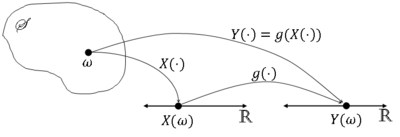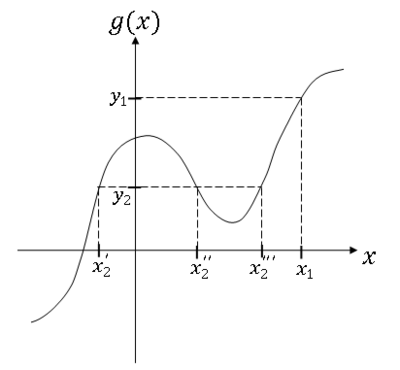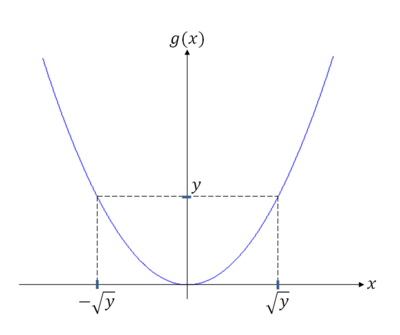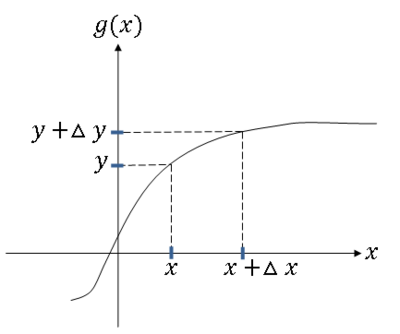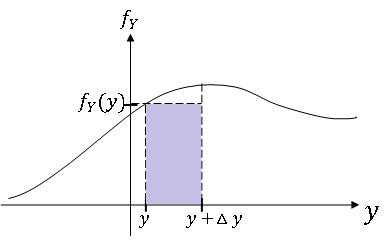Back to all ECE 600 notes
Previous Topic: Conditional Distributions
Next Topic: Expectation
The Comer Lectures on Random Variables and Signals
Topic 8: Functions of Random Variables
We often do not work with the random variable we observe directly, but with some function of that random variable. So, instead of working with a random variable X, we might instead have some random variable Y=g(X) for some function g:R → R.
In this case, we might model Y directly to get f$ _Y $(y), especially if we do not know g. Or we might have a model for X and find f$ _Y $(y) (or p$ _Y $(y)) as a function of f$ _X $ (or p$ _X $ and g.
We will discuss the latter approach here.
More formally, let X be a random variable on (S,F,P) and consider a mapping g:R → R. Then let Y$ (\omega)= $g(X($ \omega)) $ ∀$ \omega $ ∈ S.
We normally write this as Y=g(X).
Graphically,
Is Y a random variable? We must have Y$ ^{-1} $(A) ≡ {$ \omega $ ∈ S: Y$ (\omega) $ ∈ A} = {$ \omega $ ∈ S: g(X$ (\omega) $) ∈ A} be an element of F ∀A ∈ B(R) (Y must be Borel measurable).
We will only consider functions g in this class for which Y$ ^{-1} $(A) ∈ F ∀A ∈ B(R), so that if Y=g(X) for some random variable X, Y will be a random variable.
What is the distribution of Y? Consider 3 cases:
- X discrete, Y discrete
- X continuous, Y discrete
- X continuous, Y continuous
Note: you cannot have a continuous Y from a discrete X.
Contents
[hide]Case 1: X and Y Discrete
Let $ R_X $ ≡ X(S) be the range space of X and $ R_Y $ ≡ g(X(S)) be the range space of Y (i.e. the image of X(S) under g). Then the pmf of Y is
But this means that
Example $ \quad $ Let X be the value rolled on a die and
Then R$ _X $ = {0,1,2,3,4,5,6} and R$ _Y $ = {0,1} and g(x) = x % 2.
Now
Case 2: X Continuous, Y Discrete
The pmf of Y in this case is
i.e. for a given y ∈ R$ _y $, D$ _y $ is the set of all x ∈ R such that g(x) = y.
Then,
Example Let g(x) = u(x - x$ _0 $) for some x$ _0 $ ∈ R, and let Y=g(X). Then $ R_Y $ = {0,1} and
So,
Case 3: X and Y Continuous
We will discuss 2 methods for finding f$ _Y $ in this case.
Approach 1
First, find the cdf F$ _Y $.
where D$ _y $ = {x ∈ R: g(x) ≤ y}.
i.e. for a given y ∈ R, D$ _y $ is the set of all x ∈ R such that g(x) ≤ y.
Then
Differentiate F$ _Y $ to get f$ _y $.
You can find D$ _Y $ graphically or analytically
Example
For y = y$ _1 $ and y = y$ _2 $,
Then
Example Y = aX + b, a,b ∈ R, a ≠ 0
So,
Then
Example Y = X$ ^2 $
For y < 0, D$ _y $ = ø
For y ≥ 0,
So,
and
For general y, we need to find subsets of the y-axis that have solutions of the same form and solve the problems separately for the different subsets.
Approach 2
Use a formula for f$ _y $ in terms of f$ _X $. To derive the formula, assume the inverse function g$ ^{-1} $ exists, so if y = g(x), then x = g$ ^{-1} $(y). Also assume g and g$ ^{-1} $ are differentiable. Then, if Y = g(X), we have that
Proof:
First consider g monotone (strictly monotone) increasing (note that for differentiable and hence continuous functions defined for a given interval, injection implies monotonicity, hence it is sufficient to limit our analysis to monotonic functions only).
Since {y < Y ≤ y + Δy} = {x < X ≤ x + Δx}, we have that P(y < Y ≤ y + Δy) = P(x < X ≤ x + Δx).
Use the following approximations:
- P(y < Y ≤ y + Δy) ≈ f$ _Y $(y)Δy
- P(x < X ≤ x + Δx) ≈ f$ _X $(x)Δx
Since the left hand sides are equal,
Now as Δy → 0, we also have that Δx → 0 since g is continuous, and the approximations above become equalities. We rename Δy, Δx as dy and dx respectively, so letting Δy → 0, we get
We normally write this as
A similar derivation for g monotone decreasing gives us the general result for invertible g:
Note this result can be extended to the case where y = g(x) has n solutions x$ _1 $,...,x$ _n $, in which case,
For example, if Y = X$ ^2 $,
References
- M. Comer. ECE 600. Class Lecture. Random Variables and Signals. Faculty of Electrical Engineering, Purdue University. Fall 2013.
Questions and comments
If you have any questions, comments, etc. please post them on this page
Back to all ECE 600 notes
Previous Topic: Conditional Distributions
Next Topic: Expectation

